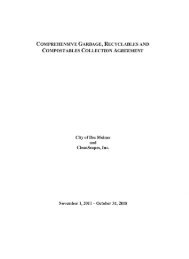CITY OF DES MOINES SHORELINE MASTER PROGRAM
CITY OF DES MOINES SHORELINE MASTER PROGRAM
CITY OF DES MOINES SHORELINE MASTER PROGRAM
Create successful ePaper yourself
Turn your PDF publications into a flip-book with our unique Google optimized e-Paper software.
Des Moines Shoreline Master Program<br />
Shoreline modifications should be limited to those modifications appropriate to the specific type<br />
of shoreline and environmental conditions for which they are proposed.<br />
If shoreline modification is approved, all feasible measures to protect shoreline ecological<br />
functions and processes should be incorporated. The City should plan for the enhancement of<br />
impaired ecological functions wherever feasible and appropriate while accommodating permitted<br />
uses.<br />
6.2.1 Bulkheads and Shoreline Stabilization<br />
Bulkheads, riprap, seawalls, or other shoreline stabilization structures are erected parallel to and<br />
near the ordinary high water mark for the purpose of protecting adjacent upland structures from<br />
the erosive action of waves or currents. While shoreline stabilization structures may protect the<br />
uplands, they do not protect the adjacent beaches, and in many cases are actually detrimental to<br />
the beaches by speeding up the erosion of the sand in front of the structures. Hard shore armoring<br />
refers to traditional designs for shoreline stabilization, including constructed steel, timber, rock,<br />
concrete, or boulder riprap. Soft shore armoring refers to alternative bank protection methods<br />
such as bioengineering or biotechnical bank stabilization, which may include use of anchored<br />
drift logs, vegetation plantings, and import of beach sediment and/or gravel (also referred to as<br />
beach nourishment).<br />
The Shoreline Administrator may approve bulkheads or other shoreline stabilization proposals<br />
when he/she determines that naturally occurring movement of the shoreline threatens existing<br />
structures, public improvements, unique natural resources, or the only feasible access to property<br />
and that the proposed stabilization complies with the criteria and standards in this section.<br />
1. New development will be located and designed to avoid the need for future shoreline<br />
stabilization to the extent feasible. New development that would require shoreline<br />
stabilization which causes significant impacts to adjacent or down-current properties and<br />
shoreline areas shall not be allowed. Subdivision of land must be regulated to assure that the<br />
lots created will not require shoreline stabilization in order for reasonable development to<br />
occur. New development on steep slopes or bluffs shall be set back sufficiently to ensure that<br />
shoreline stabilization is unlikely to be necessary during the life of the structure, as<br />
demonstrated by a geotechnical analysis.<br />
2. New hard shore armoring stabilization measures shall not be allowed except when necessity<br />
is demonstrated in the following manner:<br />
a. To protect existing primary structures: New or enlarged structural shoreline stabilization<br />
measures for an existing primary structure, including residences, should not be allowed<br />
unless there is conclusive evidence, documented by a geotechnical analysis, that the<br />
structure is in danger from shoreline erosion caused by tidal action, currents, or waves.<br />
Normal sloughing, erosion of steep bluffs, or shoreline erosion itself, without a scientific<br />
or geotechnical analysis, is not demonstration of need. The geotechnical analysis should<br />
evaluate on-site drainage issues and address drainage problems away from the shoreline<br />
edge before considering hard shore armoring techniques for shoreline stabilization.<br />
b. In support of new nonwater-dependent development, including single-family residences,<br />
when all of the conditions below apply:<br />
Department of Ecology approval effective November 1, 2010<br />
Adopted by City of Des Moines Ordinance No. 1502 69



